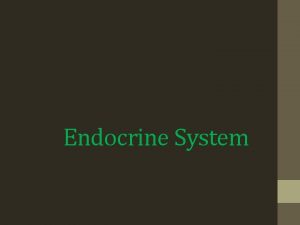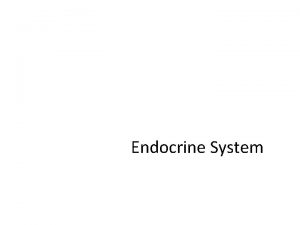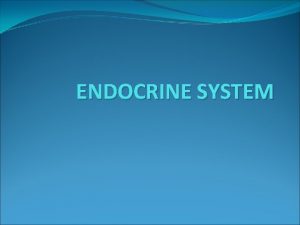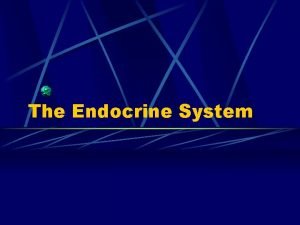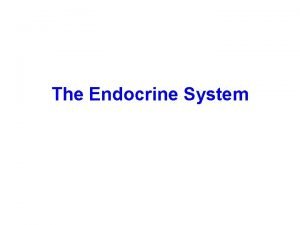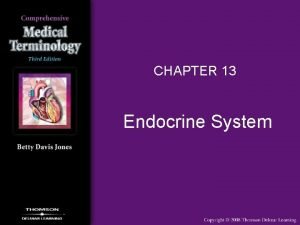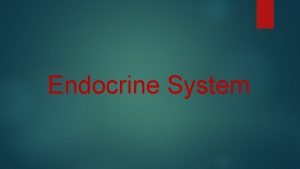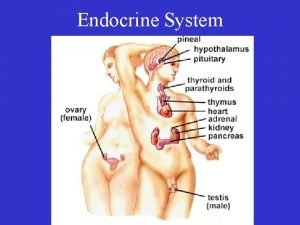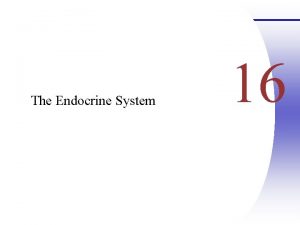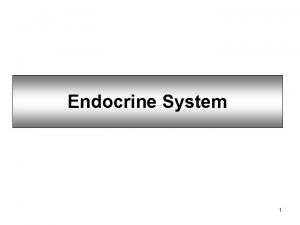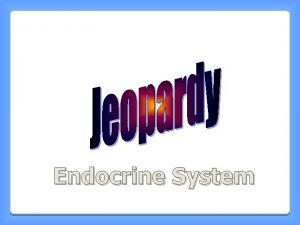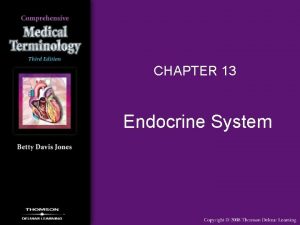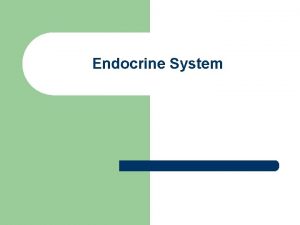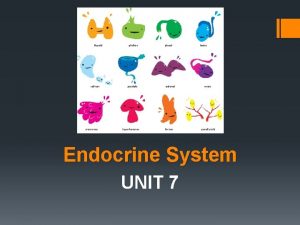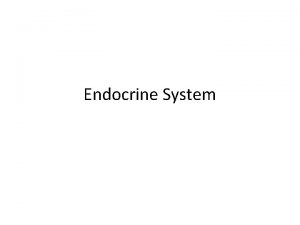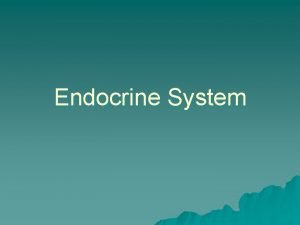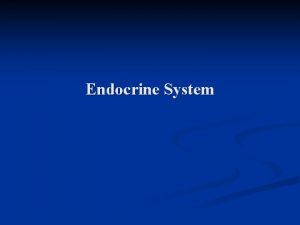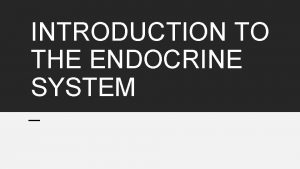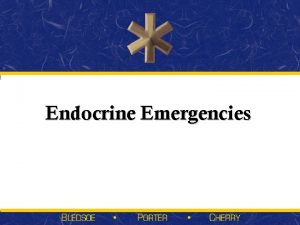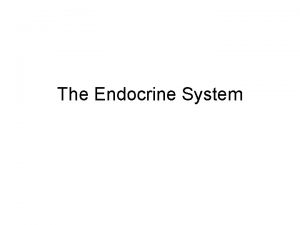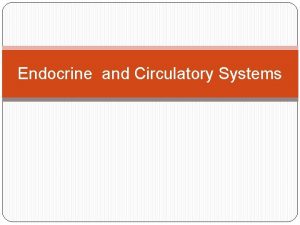Endocrine System ENDOCRINE SYSTEM The endocrine system is




























- Slides: 28

Endocrine System

ENDOCRINE SYSTEM �The endocrine system is made up of the cells, tissues, and organs that secrete hormones into body fluids such as the blood stream.

�Hormones diffuse into the bloodstream, and eventually act on cells called target cells.

General Characteristics of the Endocrine System �Glandular cells of the endocrine system release hormones into the bloodstream, which carries these messenger molecules everywhere. �The endocrine system is precise because only target cells can respond to a hormone. Target cells have specific receptors that other cells do not have.

The endocrine system helps regulate metabolic processes by: �Controlling the rates of certain chemical reactions �Aid in the transport of substances across membranes �Help regulate water and electrolyte balances �Playing a vital role in reproduction, development, and growth

Major Endocrine Glands �Pituitary gland �Thyroid gland �Parathyroid gland �Adrenal gland �Pancreas �Pineal gland �Reproductive glands �Kidneys �Thymus


Pituitary Gland � Located at the base of the brain, where a pituitary stalk attaches it to the hypothalamus.

Growth hormone (GH) �Stimulates cells to increase in size and divide more frequently �Pituitary dwarfism insufficient secretion of growth hormone; body parts normally proportioned, mental development is normal

�Gigantism oversecretion during childhood; usually a result of a tumor which can cause oversecretion of other pituitary hormones; often has several metabolic disturbances

�Acromegaly oversecretion during adulthood; enlarged heart, bones, thyroid gland, facial features, etc

Prolactin (PRL) �Milk production in lactating women

Thyroid stimulating hormone (TSH) �Controls thyroid gland secretions

Adrenocorticotropic hormone (ACTH) �Controls the hormones of the adrenal gland

Follicle stimulating hormone (FSH)/ Luteinizing hormone (LH) �Exert their actions on the gonads

Antidiuretic hormone (ADH) �Decreases urine formation. �Regulates the water concentration of body fluids.

Diabetes insipidus (too little ADH) person may produce as much as 25 -30 liters of very dilute urine per day, and solute concentrations in body fluids rise.

Oxytocin (OT) Causes contraction of the uterine walls during childbirth Contracts specialized cells associated with the milk- producing glands and their ducts. May be given to ‘induce’ labor (Pitocin) and/or following childbirth to minimize risk of hemorrhage

Thyroid Gland �Located below the larynx, anterior to the trachea �Consists of two broad lobes connected by an isthmus �Made of many secretory parts called follicles.

Thyroxine (T 4) & Triiodothyronine (T 3) �Regulate metabolism of carbohydrates, proteins, and lipids �Basal metabolic rate how many calories the body must consume at rest in order to maintain life �Required for normal growth and development �Essential to nervous system maturation

Calcitonin �Lowers blood calcium and phosphate ion concentration �Inhibits release of calcium and phosphate ions from the bones �Increases excretion of calcium and phosphate ions by kidneys

HYPOthyroidism �Common among older adults �Fatigue and weight gain �

HYPERthyroidism �Elevated metabolic rate, restlessness, and overeating �Eyes protrude because of swelling behind them �Produces a bulge in the neck because thyroid gland enlarges

11. 9 Pancreas �Endocrine (secretes hormones) and exocrine (digestive juices) gland �Located posterior the stomach � �

�Hormones of the Pancreatic Islets �Glucagon �Stimulates the liver to break down glycogen and convert certain noncarbohydrates, such as amino acids, into glucose �Raises blood sugar concentration

�Insulin �Stimulates the liver to form glycofen from glucose and inhibits conversion of noncarbohydrates �Decreases blood glucose (sugar) concentration

11. 10 Other Endocrine Glands � Pineal Gland � Located deep between the cerebral hemispheres, attached to the thalamus � Produces Melatonin: � Produced in response to light conditions received by the retinas of the eyes. � Involved in regulation of circadian rhythms of the body � Thymus � Located posterior to the sternum between the lungs � Thymosin- important in immunity � � Reproductive Glands � Testes produces testosterone � Ovaries produces estrogen & progesterone � Placenta produces estrogen, progesterone & gonadotropin

� 11. 11 Stress and Health � Physical factors include extreme heat or cold, decreased oxygen, infections, injuries, prolonged heavy exercise, and loud noises. � � Psychological factors include thoughts about real or imagined dangers, personal losses, and unpleasant social interactions or feelings of anger, fear, grief, anxiety, depression, and guilt. � Responses to Stress � USE FIGURE 11. 18 � Hypothalamus � helps prepare the body for “fight or flight” by triggering sympathetic impulses to various organs � stimulates epinephrine release, intensifying the sympathetic responses � secretes corticotropin-releasing hormones, which sets into motion more lasting responses to stress
 Endocrine system and reproductive system
Endocrine system and reproductive system Endocrine system and nervous system
Endocrine system and nervous system Lympathic
Lympathic Endo crine gland
Endo crine gland Adh function
Adh function Hình ảnh bộ gõ cơ thể búng tay
Hình ảnh bộ gõ cơ thể búng tay Frameset trong html5
Frameset trong html5 Bổ thể
Bổ thể Tỉ lệ cơ thể trẻ em
Tỉ lệ cơ thể trẻ em Chó sói
Chó sói Tư thế worm breton
Tư thế worm breton Bài hát chúa yêu trần thế alleluia
Bài hát chúa yêu trần thế alleluia Kể tên các môn thể thao
Kể tên các môn thể thao Thế nào là hệ số cao nhất
Thế nào là hệ số cao nhất Các châu lục và đại dương trên thế giới
Các châu lục và đại dương trên thế giới Công thức tính độ biến thiên đông lượng
Công thức tính độ biến thiên đông lượng Trời xanh đây là của chúng ta thể thơ
Trời xanh đây là của chúng ta thể thơ Cách giải mật thư tọa độ
Cách giải mật thư tọa độ Phép trừ bù
Phép trừ bù Phản ứng thế ankan
Phản ứng thế ankan Các châu lục và đại dương trên thế giới
Các châu lục và đại dương trên thế giới Thể thơ truyền thống
Thể thơ truyền thống Quá trình desamine hóa có thể tạo ra
Quá trình desamine hóa có thể tạo ra Một số thể thơ truyền thống
Một số thể thơ truyền thống Cái miệng nó xinh thế chỉ nói điều hay thôi
Cái miệng nó xinh thế chỉ nói điều hay thôi Vẽ hình chiếu vuông góc của vật thể sau
Vẽ hình chiếu vuông góc của vật thể sau Biện pháp chống mỏi cơ
Biện pháp chống mỏi cơ đặc điểm cơ thể của người tối cổ
đặc điểm cơ thể của người tối cổ Giọng cùng tên là
Giọng cùng tên là






























